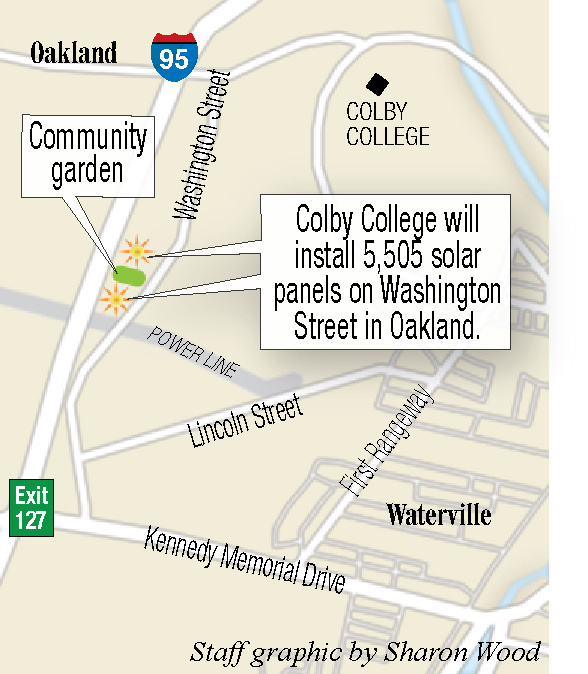More than 5,000 solar panels will be installed on Colby College property off Washington Street in Oakland this year as part of a solar energy project that will be one of the largest in the state and is expected to produce 2.5 million kilowatt hours of electricity annually for the campus, according to Colby officials.
The 5,505 panels will be installed on two sites that are about 4.5 acres each and lie to the north and south of a storage building Colby built in 2012 at 182 Washington St., which also is the site of the college’s community gardens.
The 1.9-megawatt photovoltaic energy project will produce enough energy to cover about 16 percent of Colby’s energy needs, diversify its energy supply and create a campus “living laboratory” to offer research opportunities for students and faculty members, said Doug Terp, Colby’s vice president for administration and chief financial officer.
He added that the solar project is another sign of Colby’s commitment to sustainability.
The project is the latest in a history of innovative environmental initiatives that have helped Colby become one of the first carbon-neutral colleges or universities in the country, and it earned the college one of the highest sustainability ratings in the nation, according to a Colby news release.
“Colby committed to sourcing all of its electricity from certified renewable sources in 2003,” the release said. “It was credited then for its pioneering role creating a market for purchasing green power in Maine and led the EPA to name Colby a conference champion in its College and University Green Power Challenge for many years.”
Kevin Bright, Colby’s sustainability coordinator, said Wednesday that electrical work for the project will be done between now and August, and structures that hold the solar panels will be installed sometime after that.
“The goal is to have it live in January, if not a little bit earlier,” Bright said.
The solar installation, once it’s completed, would be one of the largest in the state. While others are being planned that are similar in size to Colby’s, the largest solar installation in the state currently is at Bowdoin College, with 4,420 solar panels and a capacity of 1.2 megawatts, according to Bowdoin’s website.
To characterize the magnitude of the Colby project, Bright said an average home in the U.S. consumes about 10,000 kilowatt hours of electricity a year and the Colby installation will produce 250 times that amount.
Trees have been removed on about 2 acres of the site south of the storage building, where on Wednesday afternoon, workers with equipment were grinding up stumps. Gus Libby, Colby’s assistant director of operations and maintenance, who was at the site, will do the electrical work and help Bright oversee the solar installation.
Bright said most of the trees taken down were cut and chipped and taken to the college’s biomass plant.
“We wanted to get any of the trees down that we needed to before any birds started nesting in them,” he said.
NRG Energy Inc., based in West Windsor Township, New Jersey, and Houston, Texas, will build and own the solar project, leasing the land from Colby. As part of a 27-year agreement, Colby will buy all the electricity produced at a predetermined rate with modest cost savings expected over the life of the contract compared to projected costs for buying electricity from the grid, according to the release.
Craig Cornelius, senior vice president of NRG, who heads up renewables at the company, said in the news release that he is proud to have the opportunity to work with Colby and provide renewable energy solutions for an institution that already demonstrates an exceptional commitment to sustainability.
“Colby represents one of many organizations and companies that are driving an evolution in America’s energy mix as they seek cleaner sources of power that provide more certainty over future energy costs,” he said.
As part of the power purchase agreement, NRG pays for the construction and ongoing operating and maintenance of the 5,505 panels and Colby pays for the electrical extension and electricity produced from the panels, Bright said Wednesday.
Bright and Libby attended a City Council meeting Tuesday at which the council voted to approve the installation of an underground electrical line within part of the right of way on Washington Street.
While the property on which the panels will be installed is in Oakland, Washington Street is in Waterville, according to Waterville City Manager Michael Roy. Colby owns property on both sides of the street.
The council must take one more vote on the order, which would allow Colby to install and maintain a 12,470-volt line across parts of the street that will connect to a transformer to provide power to a student residence on the main campus, the order says.
For several years, Colby has generated about 10 percent of its electricity at its steam plant by running boiler exhaust through a turbine. Last year a 26-kilowatt photovoltaic solar array was installed on the Schair-Swenson-Watson Alumni Center on campus. Dan Chiniara, a 2013 Colby alumnus, had identified and evaluated the site as part of an environmental studies senior research project in 2012.
That solar array led the way for the current solar installation project.
“It confirmed that, once they’re installed, these things just sit up there and work for us,” Bright said in the news release. “The only real difference in that installation and the one we’re doing this summer is the scale. At its core, it’s the same thing.”
Meanwhile, Colby received permits from the town of Oakland for clearing the property and miscellaneous site and electrical work.
Washington Street stretches from the southwest end of the Colby campus to Kennedy Memorial Drive.
The site where the solar panels will be installed is less than a mile from Colby woodmen’s lot and less than a mile from Kennedy Memorial Drive.
Amy Calder — 861-9247
Twitter: @AmyCalder17
Send questions/comments to the editors.





Comments are no longer available on this story